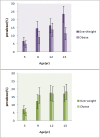Incidence and Prevalence of Childhood Obesity in Tehran, Iran in 2011
- PMID: 29308384
- PMCID: PMC5750352
Incidence and Prevalence of Childhood Obesity in Tehran, Iran in 2011
Abstract
Background: The aim of this study was to determine the incidence and prevalence of obesity in Tehranian children.
Methods: Data from children participated in Tehran Lipid and Glucose Study (TLGS) were evaluated. Cut off points for definition of obesity was the CDC's standard thresholds of the 95th percentile and 85th percentile for overweight. Prevalence, annual incidence of obesity, cumulative incidence over 10 year and the incidence density (cases per person-years) totally were calculated.
Results: The annual incidence of obesity was 1.9 and 3.4% per year in the first 3 yr and decreased to 0.9 and 2.5% in the last 3 yr of follow-up in girls and boys, respectively. Incidence density rates were in line with cumulative incidence, with a rate of 20.7 per 1000 person-years between the ages of 5.6 and 15.5 yr. The prevalence of obesity was higher among children who had obese parents (P=0.03). Among all ages, across the quartiles of parents' BMI, the prevalence of obesity increased with rising in paternal (P=0.001) or maternal BMI (P=0.004). Physical activity of mothers affected the prevalence of obesity in children at mean ages of 5.3 and 9.1 yr. Across quartiles of mother's physical activity, from heavy to light, the prevalence of obesity increased among children, from 4.4% to 5.9% in children, aged 5.3 (P=0.02) and from 11.6% to 13.0% in children, aged 9.1 yr (P=0.03).
Conclusion: Prevalence of obesity among children increased with age. Cumulative incidence of obesity in children who were overweight at baseline was much higher than other children.
Keywords: Childhood; Incidence; Iran; Obesity; Prevalence.
Conflict of interest statement
Conflict of Interests The authors declare that there is no conflict of interest.
Figures


Similar articles
-
Incidence of obesity and its predictors in children and adolescents in 10 years of follow up: Tehran lipid and glucose study (TLGS).BMC Pediatr. 2018 Jul 25;18(1):245. doi: 10.1186/s12887-018-1224-6. BMC Pediatr. 2018. PMID: 30045707 Free PMC article.
-
The effectiveness of web-based programs on the reduction of childhood obesity in school-aged children: A systematic review.JBI Libr Syst Rev. 2012;10(42 Suppl):1-14. doi: 10.11124/jbisrir-2012-248. JBI Libr Syst Rev. 2012. PMID: 27820152
-
Prevalence of underweight, overweight and obesity in preschool children of Tehran, Iran.J Res Med Sci. 2011 Jun;16(6):821-7. J Res Med Sci. 2011. PMID: 22091313 Free PMC article.
-
Overweight and Obesity: Findings from 20 Years of the Tehran Lipid and Glucose Study.Int J Endocrinol Metab. 2018 Oct 23;16(4 Suppl):e84778. doi: 10.5812/ijem.84778. eCollection 2018 Oct. Int J Endocrinol Metab. 2018. PMID: 30584443 Free PMC article. Review.
-
Metabolic Syndrome: Findings from 20 Years of the Tehran Lipid and Glucose Study.Int J Endocrinol Metab. 2018 Oct 21;16(4 Suppl):e84771. doi: 10.5812/ijem.84771. eCollection 2018 Oct. Int J Endocrinol Metab. 2018. PMID: 30584438 Free PMC article. Review.
Cited by
-
Translation, Cross-Cultural Adaptation, and Validation of the Persian Version of Thailand Physical Activity Children Survey Questionnaire.Int J Prev Med. 2022 Aug 8;13:113. doi: 10.4103/ijpvm.IJPVM_705_20. eCollection 2022. Int J Prev Med. 2022. PMID: 36247190 Free PMC article.
-
The Mediating Effects of Eating Disorder, Food Addiction, and Insomnia in the Association between Psychological Distress and Being Overweight among Iranian Adolescents.Nutrients. 2020 May 11;12(5):1371. doi: 10.3390/nu12051371. Nutrients. 2020. PMID: 32403387 Free PMC article.
-
The Impact of Physical Activity on Non-communicable Diseases: Findings from 20 Years of the Tehran Lipid and Glucose Study.Int J Endocrinol Metab. 2018 Oct 14;16(4 Suppl):e84740. doi: 10.5812/ijem.84740. eCollection 2018 Oct. Int J Endocrinol Metab. 2018. PMID: 30584431 Free PMC article. Review.
-
Incidence of obesity and its predictors in children and adolescents in 10 years of follow up: Tehran lipid and glucose study (TLGS).BMC Pediatr. 2018 Jul 25;18(1):245. doi: 10.1186/s12887-018-1224-6. BMC Pediatr. 2018. PMID: 30045707 Free PMC article.
-
Iranian children with overweight and obesity: an internet-based interventional study.BMC Pediatr. 2021 May 6;21(1):221. doi: 10.1186/s12887-021-02684-2. BMC Pediatr. 2021. PMID: 33957878 Free PMC article. Clinical Trial.
References
LinkOut - more resources
Full Text Sources
